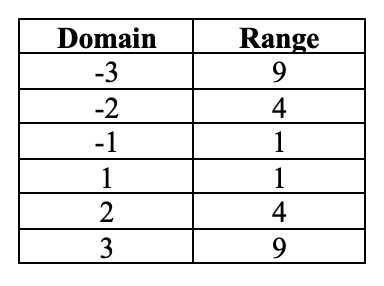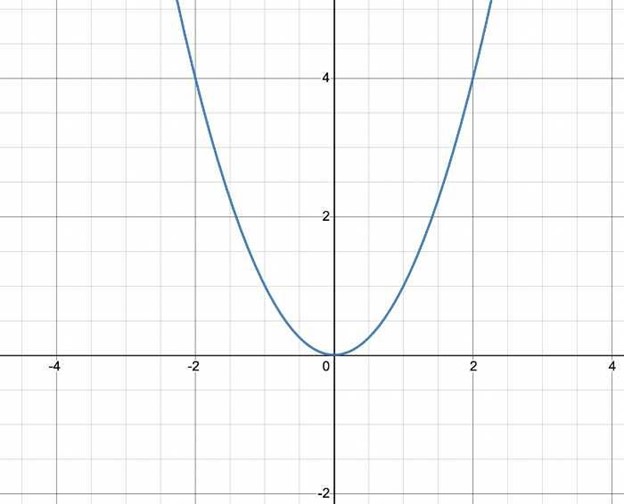One to One Functions - Graph, Examples | Horizontal Line Test
What is a One to One Function?
A one-to-one function is a mathematical function where each input corresponds to just one output. So, for each x, there is only one y and vice versa. This implies that the graph of a one-to-one function will never intersect.
The input value in a one-to-one function is the domain of the function, and the output value is the range of the function.
Let's study the pictures below:

For f(x), every value in the left circle corresponds to a unique value in the right circle. In conjunction, any value in the right circle corresponds to a unique value in the left circle. In mathematical terms, this means that every domain owns a unique range, and every range owns a unique domain. Thus, this is an example of a one-to-one function.
Here are some different examples of one-to-one functions:
-
f(x) = x + 1
-
f(x) = 2x
Now let's examine the second example, which exhibits the values for g(x).
Be aware of the fact that the inputs in the left circle (domain) do not hold unique outputs in the right circle (range). For instance, the inputs -2 and 2 have equal output, in other words, 4. In the same manner, the inputs -4 and 4 have identical output, i.e., 16. We can discern that there are matching Y values for multiple X values. Thus, this is not a one-to-one function.
Here are additional examples of non one-to-one functions:
-
f(x) = x^2
-
f(x)=(x+2)^2
What are the properties of One to One Functions?
One-to-one functions have these qualities:
-
The function has an inverse.
-
The graph of the function is a line that does not intersect itself.
-
They pass the horizontal line test.
-
The graph of a function and its inverse are the same concerning the line y = x.
How to Graph a One to One Function
When trying to graph a one-to-one function, you are required to figure out the domain and range for the function. Let's study a straight-forward representation of a function f(x) = x + 1.

As soon as you possess the domain and the range for the function, you need to graph the domain values on the X-axis and range values on the Y-axis.
How can you tell if a Function is One to One?
To prove whether a function is one-to-one, we can apply the horizontal line test. Immediately after you graph the graph of a function, draw horizontal lines over the graph. If a horizontal line passes through the graph of the function at more than one point, then the function is not one-to-one.
Due to the fact that the graph of every linear function is a straight line, and a horizontal line doesn’t intersect the graph at more than one spot, we can also reason that all linear functions are one-to-one functions. Remember that we do not apply the vertical line test for one-to-one functions.
Let's examine the graph for f(x) = x + 1. Immediately after you plot the values for the x-coordinates and y-coordinates, you need to consider if a horizontal line intersects the graph at more than one spot. In this example, the graph does not intersect any horizontal line more than once. This signifies that the function is a one-to-one function.

On the contrary, if the function is not a one-to-one function, it will intersect the same horizontal line more than once. Let's study the graph for the f(y) = y^2. Here are the domain and the range values for the function:

Here is the graph for the function:

In this case, the graph meets various horizontal lines. For instance, for both domains -1 and 1, the range is 1. Similarly, for both -2 and 2, the range is 4. This implies that f(x) = x^2 is not a one-to-one function.
What is the opposite of a One-to-One Function?
Considering the fact that a one-to-one function has a single input value for each output value, the inverse of a one-to-one function also happens to be a one-to-one function. The opposite of the function essentially reverses the function.
For example, in the example of f(x) = x + 1, we add 1 to each value of x in order to get the output, in other words, y. The inverse of this function will deduct 1 from each value of y.
The inverse of the function is known as f−1.
What are the characteristics of the inverse of a One to One Function?
The characteristics of an inverse one-to-one function are no different than all other one-to-one functions. This means that the inverse of a one-to-one function will have one domain for every range and pass the horizontal line test.
How do you figure out the inverse of a One-to-One Function?
Figuring out the inverse of a function is very easy. You just have to change the x and y values. For example, the inverse of the function f(x) = x + 5 is f-1(x) = x - 5.

As we discussed earlier, the inverse of a one-to-one function undoes the function. Because the original output value required us to add 5 to each input value, the new output value will require us to delete 5 from each input value.
One to One Function Practice Questions
Consider the following functions:
-
f(x) = x + 1
-
f(x) = 2x
-
f(x) = x2
-
f(x) = 3x - 2
-
f(x) = |x|
-
g(x) = 2x + 1
-
h(x) = x/2 - 1
-
j(x) = √x
-
k(x) = (x + 2)/(x - 2)
-
l(x) = 3√x
-
m(x) = 5 - x
For every function:
1. Figure out if the function is one-to-one.
2. Graph the function and its inverse.
3. Determine the inverse of the function mathematically.
4. Specify the domain and range of both the function and its inverse.
5. Employ the inverse to solve for x in each equation.
Grade Potential Can Help You Master You Functions
If you find yourself having problems using one-to-one functions or similar concepts, Grade Potential can put you in contact with a private tutor who can help. Our Ann Arbor math tutors are experienced professionals who assist students just like you advance their understanding of these concepts.
With Grade Potential, you can work at your unique pace from the convenience of your own home. Book an appointment with Grade Potential today by calling (734) 875-9383 to learn more about our educational services. One of our consultants will contact you to better determine your needs to find the best tutor for you!




